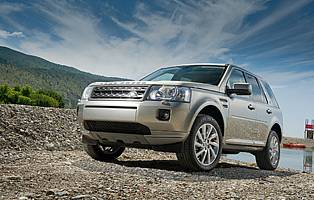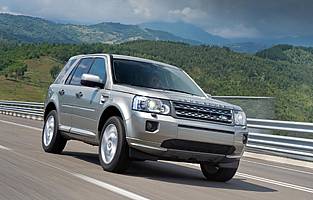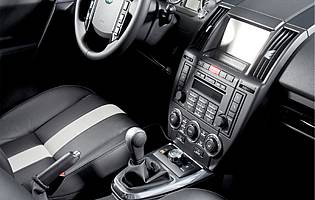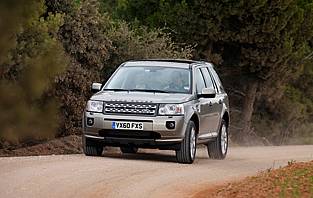



Overall rating
![]()
Subtle cosmetic changes don't detract from familiar looks




![]()
Despite the 'baby' Land Rover tag the Freelander is far more capable off-road than any close rival. It's also good on road, which is where most cars stay. As such, the benefits of an SUV-like car with only front-wheel drive - in a bid to boost economy and emissions - has been visited by an increasing number of car makers. Land Rover has finally took the plunge with its Freelander.
Now more overtly premium in its fit, finish, appearance and asking price, the Freelander offers buyers an above average ownership experience in the SUV market. Also, the firm's reputation is heavily built around the ability to traverse challenging terrain. Offering essentially a front-wheel drive alternative could be seen as risky. But, along with an increasing number of makers, chasing lower CO2 ratings has become important, making it only a matter of time before such a car appeared.
In reality, the concept of a 'less capable' Freelander will only be a concern for a few Land Rover stalwarts. For the rest, the prospect of all the positive attributes - brand image, luxury, refinement - easily outweigh the car's reduced capabilities. This two-wheel drive Freelander is no bargain entry-level model, either. It might only be available with the low power 150 horsepower diesel engine and a manual gearbox, but this combination perfectly reflects the car's on-road aspirations.
On the road this particular Freelander turns in a polished performance. For general driving duties the all-wheel drive element is rarely missed, and even when driving sensibly it will easily cope with mildly slippery conditions. With the right tyres - so often the key component when off-roading - it's more adept than you might think.
While you do without the Terrain Response function of the all-wheel drive variants for obvious reasons, you gain a more appropriate engine stop-start feature. Increasingly common in a bid to reduce fuel consumption and emissions, its large cars like SUVs that often benefit the most. The Freelander's system works well and shuts down and starts up the engine with minimal delay.
The Freelander's steady move upmarket has been a successful one in terms of the car's performance, cabin ambience and overall levels of refinement. This move has also attracted an increasing number of people less interested in off-road performance and more interested in the car's premium attributes and brand image. For those people, a more economical and cheaper to run version should prove particularly attractive.
The predictable rise in the Freelander's asking price thanks ot recent and significant quality improvements have pushed the car closer to premium German rivals. As such, choose your optional carefully - few will greatly influence the car's residual value - and opting for the most frugal diesel varaint will help matters.In light of the savings offered by the two-wheel drive variant, think carefully before opting for a regular model - do you really need its extra ability? Quality improvements should see servicing as nothing more than routine.
Nnoticably bigger car than the first generation model, cabin space is decent by current standards. There are also a useful number of storage areas in the cabin, especially the capacious box under the front armrest. At the rear, the back seats fold flat to further extend the load space and the tailgate opens high and wide for easy access, although it does require a hefty pull to close.
Many of the Freelander's controls and displays are similar to those found in the Discovery and Range Rover Sport. Classy, minimalistic dials and lots of black plastic combine to promote a 'utility-chic' appearance. The car's mainly black central area houses the audio and ventilation controls - the former located higher than the former. Topping these is the colour display that can double as the touch screen sat-nav. The sea of minor switchgear can initially be a little confusing, though.
The Freelander's seats are pleasingly supportive - especially so if you ever decide to venture off-road. Back on the road, the only obvious noise is a small amount of wind and tyre noise. The diesel engines can clatter a little when cold, but this disapears once warmed up.
Although the remote central locking plus the alarm and imobilisor package should prove more than adequate, a visible device such as a steering lock or even a tracking device if you plan on owning a high-spec varaint would increase peace of mind and, in the case of the latter, could reduce your insurance premium.
Present in the Freelander are the usual traction and stability controls. Remember, these have also been tuned to provide assistance off road, although they can be switched off to assist the two-wheel drive varaint if a small amount of wheelspin is desired. Elsewhere, the cabin boasts seven airbags - including one for the driver's knee area.
The Freelander boasts a high ground clearance, yet it resists pitch and roll well when driven on road. Grip levels are high despite 'only' being two-wheel drive, although wheelspin and torquesteer is present if the car is provoked. At all other times you wouldn't know the difference. The diesel engines pull strongly, although they do need to be worked hard if brisk on-road performance is required, and they can prove quite vocal when worked hard.
While it would be wrong to compare the Freelander to a comparable size people carrier, the Land Rover's lofty stance and bash-proof exterior will no doubut appeal to active families. Even in two-wheel drive form the car is more competent than your average family car. The optional rear audio system will be a boon on long journeys, and its generous load carrying capacity is another plus.
An easy car to drive, its controls are light and visibilty is good from the lofty driving position making it ideal for a novice driver. However, it's not a cheap car to buy and run even in two-wheel drive form, while parking and manouvering the Freelander in tight spaces is likely to challenge an inexperienced driver.
For many years a solid brand image has been a cornerstone of Land Rover offerings. The firm might have struggled with build quality quality issues in recent years but its latest products reflect a much improved performance. There's no question that what you can see and touch is better than before, And mechanical reliability is said to be more robust. The inclusion of a two-wheel drive model is unlikely to reverse this view as, more lilkely, it will appeal to a wider customer base less interested in off-roading activities.
Although less car-orientated than some SUVs because it remains a 'proper' off-roader, this does mean more of a stretch for less able bodied occupants to access the cabin. The same is true when you get out - there's more of a pronounced step down than with certain rivals. At the rear, the car's high ground clearance pays off as the boot floor is near waist height, making loading and unloading easy.
The Freelander's standard fit radio and CD player combination works well and the unit is placed high up for ease of use, although the sea of of buttons can initially be a drawback - the steering wheel controls are most welcome, though. Numerous options exist, including better amplification, MP3 player intergration, rear seat audio connections and a full-colour touch screen sat-nav. The latter is very impressive and is quick to respond to route changes but route programming could be more intuitive.
Darker exterior hues suggest a more premium feel and will no doubt better asssit the Freelander come trade in time. Inside, numerous trim combinations exist, and again it's the darker options that work the best, be they leather or fabric - that also goes for the fascia trim, as the lighter options won't wear so well.
While the Freelander might appear big by family car standards it is no more difficult to park than your average hatchback. The lofty driving postion helps, as does the light steering. The car's large side mirrors prove very useful. Predictably, parking sensors are also a big help.
Spare wheel is located at the rear underneath the car.
Engine range: 2.2-litre TD4 diesel (150bhp, 190bhp). Six-speed manual fitted as standard to 150bhp variant, six-speed auto fitted to 190bhp model - optional on lesser powered Freelander but not 2WD varaints. Trim levels: S, GS, XS, HSE.
Honda CR-V Honda's CR-V is well built and refined but better suited to on-road duties
BMW X3 Premium SUV boasts a premium price tag and isanother road biased SUV
Hyundai Santa Fe Affordable alternative lacks Freelander's brand image but boasts a spacious cabin, is well equipped and capable
Volkswagen Tiguan Upmarket Freelander alternative biased towards road use. Styling is a little unadventurous